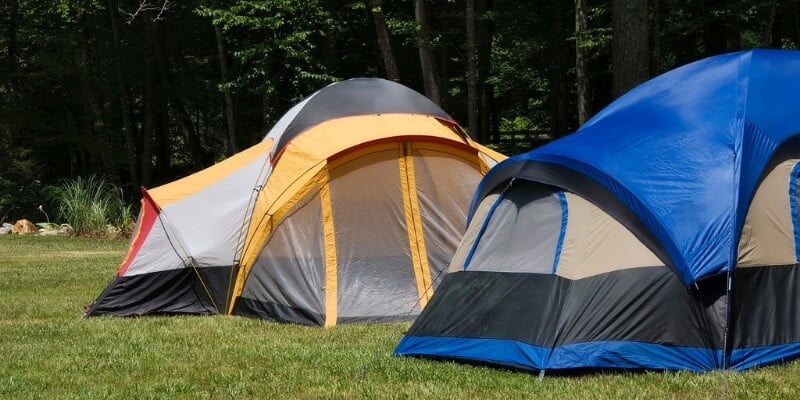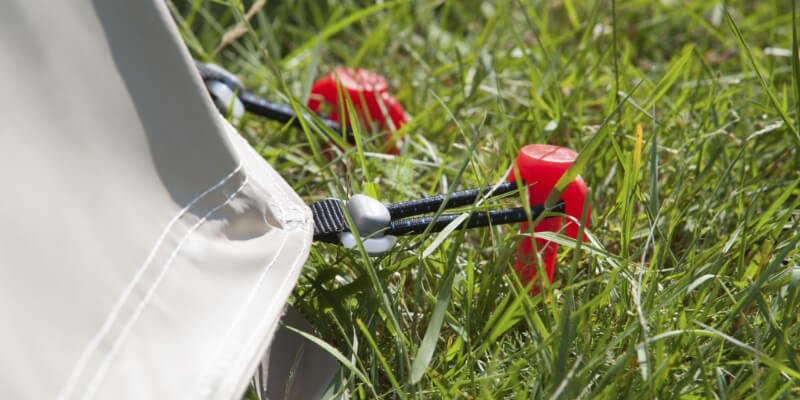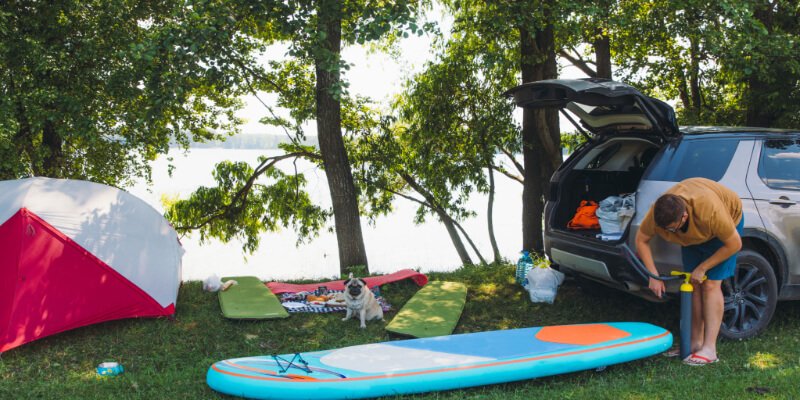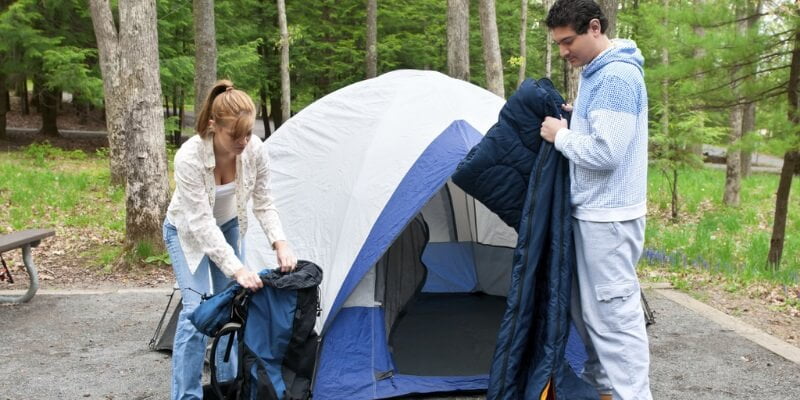How to Remove Mold Stains from Tents
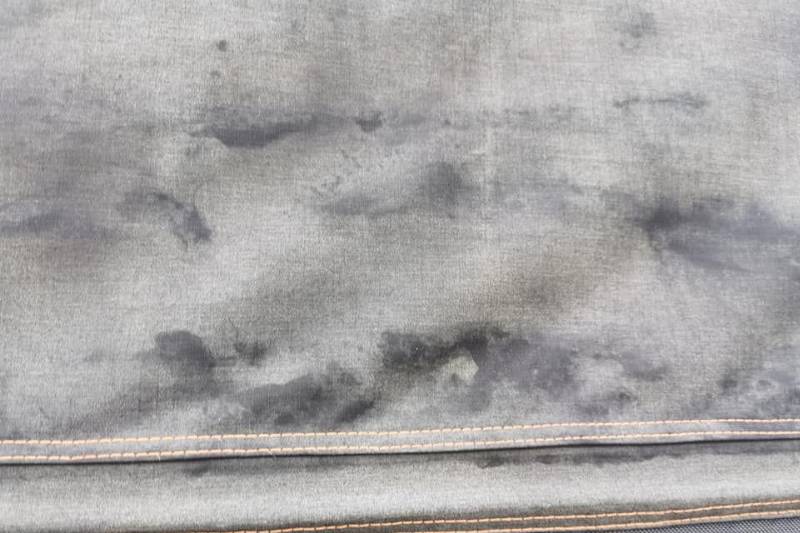
Mold stains on the tent look ugly. But there are other reasons why you should remove them quickly. In this guide, you will learn how to do it correctly. And how you can prevent mold stains in the future.
What Are Mold Stains?
Mold stains are yellow, brown, or dark gray discolorations caused by moisture. Most of the time, mold stains have a musty odor. Tents made of cotton and other natural fibers are particularly affected. Mold stains can appear on polyester and nylon tents but are rare. Unfortunately, even after the tent material has dried, mold stains do not go away by themselves. They have to be treated.
How Do Mold Stains Develop on a Tent?
The cause of mold stains is moisture that persists for a long time. This is why tents made of absorbent materials, such as cotton, polycotton, and linen get mildew stains particularly quickly.
Did you dismantle your tent after a rain shower, put it in the wet pack bag, and store it on the shelf at home? These are ideal conditions for mold stains. However, a tent can also develop mold spots while it is set up, especially when the weather is damp for a long time and the tent is in the shade all day.
How Dangerous Are Mold Stains?
Mold stains on the tent are harmless and a visual problem. However, they are a serious warning sign of greater danger. In the damp environment in which the foxing stains occurred, the tent fabric will deteriorate over time. Cotton rots and Polyurethane, which is the coating most synthetic fiber tents are made of, become brittle. This can lead to a total loss of the tent.
Mold stains practically always contain mold spores. If you don’t take action against the mold stains, mold will likely grow on the tent at some point. Mold is a serious threat to your health.
What should I do if I discover a mold stain on the tent?
I recommend two measures.
- Treatment of the mold stains. The mold stains should be removed. Your tent is more beautiful without discoloration. What is even more important however is that any incipient mold growth, which may still be invisible to the eye, is nipped in the bud. I provide you with several instructions for different types of mold stains.
- Prevent new mold stains. You have to change the location of your tent, improve the storage conditions, clean your tent, or make your tent fabric more resistant to mold stains with an impregnation.
At the end of this guide, you will learn the easiest way to do it.
Act quickly!
Fresh mold stains are often easy to remove. Over time, they can completely dye the material fibers. Then mold stains are extremely difficult and treatable with strong bleaches.
1. Remove Fresh Mold Stains from Polyester
Fresh mold stains on polyester and nylon tents should be easy to remove. They only sit on the surface of the synthetic fibers and have not penetrated the material. Maybe it’s not real mold stains, but mud stains, sap (wet grass is particularly notorious), algae, or bacteria that can grow on tents in a humid environment. All of these stains can be easily rubbed off polyester tents with a little mild detergent and water.
Which accessories do I need?
I choose a gentle, fragrance-free cleaning agent that does not attack the tent fabric and does not leave any unwanted residue. Curd soap works well.
A water-based, biodegradable tent cleaner is even gentler on the tent. I like to remove stains with Nikwax Tech Wash and thus refresh the water-repellent properties of the treated tent fabric when cleaning it. This will help prevent further mold stains in the future.
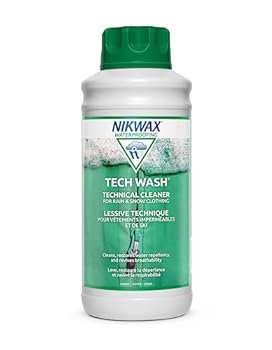
Nikwax Tech Wash (tent cleaner)
You will also need a bucket of lukewarm water and a soft cloth.
Instructions:
- Dilute the cleaner with a little water and spray the mold stain thoroughly.
- Let the cleaner work for 10 minutes.
- Then rub the stain gently with a soft cloth or brush.
- Rinse with plenty of clean water.
- Repeat the first 4 steps until the foxing stain has disappeared.
- Let the tent dry completely before packing it up again.
You can effectively remove fresh mold stains on artificial materials with this simple measure. However, older mold stains and stains on cotton tents sometimes require tougher measures.
2. Remove Stubborn Mold Stains from Synthetic Fiber Tents
After a while, mold stains can even penetrate synthetic fibers. Then it is more difficult but still possible to remove them. Since I want to protect the tent material, I try to remove the stains with the mildest possible cleaning agent. You can first try to remove the stains. This method is very gentle on the tent material and is quick. If that doesn’t help, you need something stronger. Rubbing alcohol works well and is compatible with many plastics.
Tents made of synthetic fibers (polyester, nylon) must not be worked on with very sharp or abrasive cleaners and tools. So scouring milk, chlorine cleaner, and pot sponges are taboo. Otherwise, it can happen that the sensitive, waterproof coating of the tent fabrics is worn away. The tent is then no longer waterproof.
Which accessories do I need?
High-percentage isopropyl alcohol is well tolerated by the polyurethane coating on the tents. It leaves no residue, and its smell dissipates quickly.
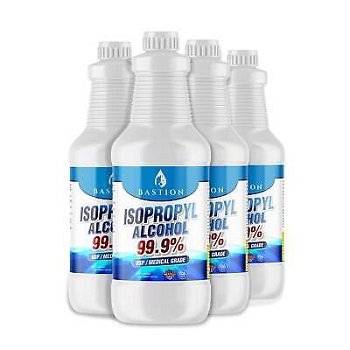
Instructions:
- Spray the mold stains with copious amounts of isopropanol. The fabric can be properly soaked.
- Wait for the alcohol to dry.
- Rub the treated areas with a soft cloth and plenty of clean water.
- Repeat the process until the mold stains are gone.
- Renew the impregnation on the cleaned areas.
- Let the tent dry completely before packing it up again.
Rubbing alcohol removes almost any stain on plastic tents. If the stubborn mold stain still spreads across your tent after this treatment, only bleach will help.
Which bleach do I need?
Chlorine-based bleaches are far too aggressive for tents with a PU coating. However, hydrogen peroxide (H2O2) is better for the tent material and also has a good effect. You can buy this hydrogen-oxygen compound in the pharmacy. A user-friendly alternative is stain removers and mold removers in spray bottles that contain hydrogen peroxide.
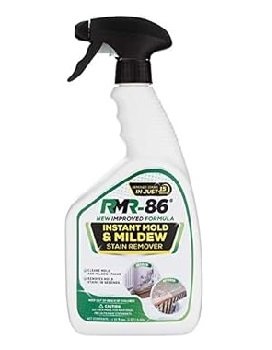
Instant Mold & Mildew Stain Remover
Instructions:
Warning: bleach doesn’t just bleach mold stains! With a little bad luck, the color of the tent fabric and your clothes will also disappear. So test in an inconspicuous place. Avoid skin contact. Read manufacturer information.
- There are more aggressive bleaches out there. Nevertheless, I recommend for your safety: Wear gloves, protective goggles and old clothes.
- Spray the foxing stains and leave them on for at least 20 minutes. Leave on for at least 1 hour for heavy stains.
- Rinse the areas with a soft sponge and plenty of clean water.
- Repeat the process until the mold stains are gone.
- Freshen up the impregnation on the bleached areas.
- Before you pack your tent away, dry it thoroughly.
3. Remove Fresh Mold Stains from Cotton Tents
On a cotton tent, mold stains can appear within a few days. Over time, they penetrate the cotton fibers deeper and deeper. Therefore, you should remove the mold stains as soon as possible. In cotton, mildew stains can really get stuck. Fortunately, cotton has good chemical resistance and we are also allowed to use strong detergents.
Which means do I need?
Before you launch the very heavy guns (read: chlorine cleaner), you can try to wash the foxing stain from your cotton tent with acetic acid. Acetic acid is found in normal vinegar and, in higher concentrations, in vinegar essence. Both are available for little money in the nearest supermarket.
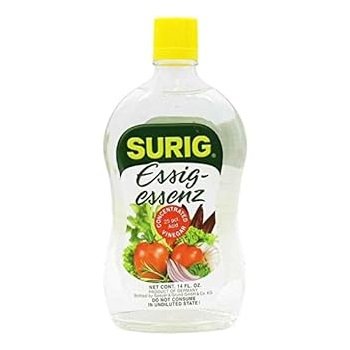
Instructions:
- Dilute vinegar essence with more than 50% acid in a 1: 1 ratio with water or wear protective goggles and gloves.
- Spray the mold stains with vinegar essence until they are well soaked.
- Let the vinegar essence work for 30 minutes.
- Wash the area with a soft brush and plenty of water. Rinse with plenty of clean water.
- Repeat the process until the foxing stain is gone.
- Re-impregnate the treated areas.
- Let the tent dry completely before packing it up again.
You can use vinegar essence to remove a lot of fresh mold stains and other discolorations on cotton tents. However, tougher measures are sometimes required for older mold stains.
4. Remove Stubborn Mold Stains from Cotton Tents
After a while, foxing stains dyed the fibers of the cotton fabric. They are now very difficult to remove. A tent cleaner or vinegar essence won’t help anymore.
We are now using the strongest remedy in our arsenal: chlorine. Chlorine has a strong oxidizing effect and is therefore ideal for bleaching stains. Fortunately, cotton resists chlorine well.
Which cleaning agent do I need?
Since older mold stains on cotton tents usually contain a lot of mold spores, we use a chlorine-based mold remover.
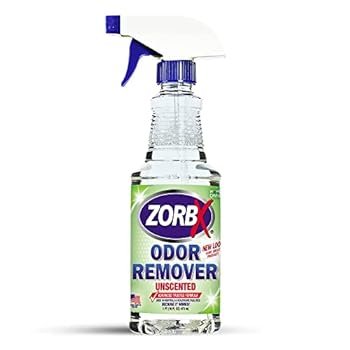
Instructions:
- Chlorine must never be mixed with acidic cleaning agents. Hazardous chlorine gas can be produced.
- The chlorine cleaner has a strong irritant effect on the mucous membranes in the eyes and lungs. Ventilate the application site well. Wear gloves and safety glasses.
- The bleaching effect is really strong. That means: In addition to mold stains, any other color from the tent can also be bleached. However, I advise you to use the product only on undyed fabrics.
- Put on gloves, safety glasses, and old clothes. Make sure there is good ventilation.
- Spray the foxing stains and leave them on for at least 30 minutes.
- Rinse the areas with a soft sponge and plenty of clean water.
- Repeat the process until the mold stains are gone.
- Freshen up the impregnation on the bleached areas.
- Before you pack your tent away, dry it thoroughly and let it air out.
After using chlorine, your tent can smell like a swimming pool for several hours. On the other hand, chlorine works really well against mold stains.
Tips for Preventing Mold Stains on the Tent
To avoid mold stains on the tent, you should always keep it dry and clean.
Dry the tent properly
Most foxing stains occur when a tent is put into the pannier when it is wet and kept that way for a long time. The tent doesn’t have to be soaking wet from the rain, a little morning dew can be enough. Always dry your tent completely before storing it. The sun is helpful here: its rays accelerate the drying process and kill mold at the same time.
Keep the tent clean
Mold spores and microbes can accelerate the formation of mold stains. With a few simple cleaning measures, you can save your tent from this fate.

Re-impregnate the tent
The impregnation applied to the tent by the manufacturer will wash off over time. The tent fabric then absorbs more water and becomes more susceptible to foxing. However, you can re-impregnate your tent yourself. That’s not hard. And is really helpful in keeping your tent dry & clean.
Further measures to avoid mold stains on the tent
Cotton tents in particular should dry out properly every few days on the campsite. Avoid placing them under trees or on fallen leaves during the cold season. The room in which you store your tent at home should have less than 55% humidity if possible.
Also read:
- Camping in the rain: How to stay dry in the tent! (20 tips)
- How you make tent lines visible: (4 tips)
Conclusion
To summarize again: Mold stains on the tent occur if the tent is damp for too long. Adhering to dirt and the absence of sunlight accelerates the process. Mold stains are ugly, but not dangerous. However, they are a warning sign of impending damage to the tent, which can lead to a total loss.
Fresh mold stains are easier to remove than old mold stains because they have not yet penetrated the fibers of the tent material. So remove it as soon as you discover the discoloration!
When tents are made of polyester and nylon, you can usually remove mold stains quite easily with a tent cleaner or rubbing alcohol. On the other hand, when tents are made of cotton, linen or polycotton, mold stains can be extremely persistent. If vinegar essence doesn’t help, you will likely need a strong chlorine-based bleach.
Ideally, always choose the mildest cleaning agent to protect the tent fabric. It is of course best if your tent does not get any mold stains at all. If you store your tent correctly and dry it properly, you have the two most important causes under control. Occasional refreshing of the impregnation is also helpful.
Frequently Asked Questions
Here you will find answers to questions most readers have asked…
Mildew and mold are both types of fungi, but they have some key differences. Mildew refers to specific types of mold that typically grow on plants or damp surfaces. It often appears as a powdery or downy growth and is usually white, gray, or yellowish. Mildew thrives in warm, humid environments and is commonly found on fabrics, paper, and organic materials.
On the other hand, mold is a broader term that encompasses various types of fungi. It appears in a range of colors, including black, green, and brown, and has a fuzzy or slimy texture. Mold can grow on a wider variety of surfaces, including wood, drywall, and tile grout. It thrives in moist, dark environments and can cause more significant damage to both property and health if not properly addressed.
Yes. Stain removers for clothing also work in combination with a washing machine on tents. But: In the washing machine, with a little bad luck, stuck seam tapes on synthetic fiber tents can peel off. Cotton tents can run in. Therefore, a tent should not be washed at more than 30 degrees and without a spin. Hand washing is even gentler and therefore recommended. In any case, the impregnation of the tent should be renewed after washing.
Vinegar, buttermilk, and sunbeams – there are many readily available home remedies that you can use to remove mold stains from all sorts of objects and tents.
I mostly advise against it for the following reasons:
- Buttermilk contains very little acid. You will need to soak the tent fabric in buttermilk for 1 to 2 days to be effective. Afterward, buttermilk leaves fat and protein stains that you need to take care of.
- UV rays from the sun reliably bleach mold stains over the course of a few days. However, they also bleach any other color from your tent fabric and over time lead to UV damage such as material embrittlement. This is especially the case with synthetic fiber tents.
- Vinegar is critical for synthetic fiber tents as vinegar attacks polyurethane. In the case of cotton tents, the effect of vinegar is satisfactory.
Instead of buttermilk etc., I therefore prefer to use cleaning agents for my tents that are made for the requirements of a tent.
Yes. Caravan awnings, pavilions and tarps are often made of a fabric made of synthetic fibers or cotton. Therefore, you can use the cleaning agents and techniques presented above to clean them up. Before treatment, please check whether the cleaning agent is compatible with the material of your tent or pavilion.
That makes sense. If you treated your tent with cleaning agents or scrubbed it, some of the impregnation agents have been lost in the treated areas. If you renew it, the tent will become water-repellent again and will be better protected from new mold stains in the future.
Yes, many professional cleaning services offer mold stain removal. They use specialized products and techniques to effectively eliminate mold stains from surfaces. Contact local cleaning companies to find one that fits your budget and needs.
Mold stains are often accompanied by a musty odor. Odors can be even more persistent than stains. After removing the stains, is the smell still there? Then maybe only an enzyme cleaner can help.
- Determine what materials your tent is made of. Common materials are polyester, polyurethane, nylon, silicone, cotton, and PVC.
- Find out what active ingredient your detergent has. It’s a little bit of detective work sometimes. The active ingredient hydrogen peroxide can also appear in the list of contents under the name active oxygen.
- Find out what chemical resistance your tent fabric has to the active ingredient.

